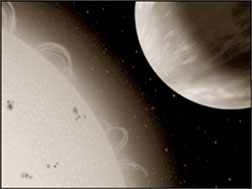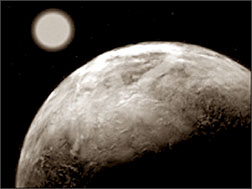Planet hunters spy distant haul
|

The ice-giant Gliese 436 is 30 light years from Earth
|
A haul of 28 new planets beyond our solar system has been detected by
the world's most prolific planet hunters.
The finds were among 37 objects seen orbiting distant stars by a US
and Anglo-Australian team in the last year.
Other objects reported by the group, at an American Astronomical
Society meeting in Honolulu, included five failed stars, known as brown
dwarfs.
The finds increase the total number of known exoplanets to 236, more
than half of which were discovered by the team.
"The more we look, the more we find planets," said Professor Tinney
of the University of New South Wales, head of the Australian part of the
Anglo-Australian Planet Search.
"Super-Earth"
Among the finds were at least four multiple-planetary systems. All of
the planets were so-called gas giants, similar to Jupiter, with no solid
surface.
"Something like 10 to 15% of stars host gas giants," said Professor
Tinney. "A larger fraction of stars may host planets too small for us to
detect."
These could include Earth-sized objects, which could harbour life.
Earlier this year, scientists using the European Southern Observatory
(ESO) 3.6m Telescope in Chile discovered the smallest exoplanet - as
astronomers call planets that orbit a star other than the Sun - yet.
|

The smallest exoplanet discovered orbits
Gliese 581 |
The "super-Earth" orbited the faint star Gliese 581, 20.5 light-years
away in the constellation Libra. Its radius was just 1.5 times that of
the Earth.
Intriguingly, the planet could have liquid water on its surface, a
key ingredient of life. It was discovered using a sensitive instrument
that can measure tiny changes in the velocity of a star as it
experiences the gravitational tug of a nearby planet.
It was the same method used to detect the latest batch of extra solar
planets.
According to Dr Jason Wright of the University of California,
Berkeley, one of the members of the US California and Carnegie Planet
Search, the technique has become more sophisticated, improving detection
rates dramatically.
"We're just now getting to the point where, if we were observing our
own Solar System from afar, we would be seeing Jupiter," he said. These
techniques allow scientists to detect changes in the motion of stars as
small as one metre per second.
Astronomers are stuck with such indirect methods of detection because
current telescope technology struggles to image very distant and faint
objects - especially when they orbit close to the glare of a star.
Ice planet
The discovery of the 28 new planets has given astronomers new targets
to analyse in more detail. Presenting the findings, Professor Geoff
Marcy singled out a planet discovered two years ago, which had already
yielded a mass of "extraordinarily rich" information.
Circling the star Gliese 436, 30 light years from Earth, was an
ice-giant planet that was calculated by Swiss and Belgian scientists to
be at least 22 Earth masses, slightly larger than the mass of Neptune.
Their studies had also revealed its density.
"It must be 50% rock and about 50% water, with perhaps small amounts
of hydrogen and helium," said Professor Marcy.
"This planet has the interior structure of a hybrid
super-Earth/Neptune, with a rocky core surrounded by a significant
amount of water compressed into solid form at high pressures and
temperatures."
However, the planet is not thought to be capable of supporting life.
BBC
|
